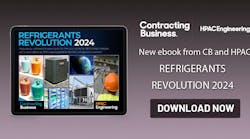Those who know me well know I love football, especially the college game (Go Hokies!). This time of year, with all of the bowl games (and, obviously, the National Football League playoffs and Super Bowl), we get a lot of big-time competition. That got me thinking about how our industry—the manufacturers of HVAC products in particular—compares to major college athletic programs.
In recent years, one of the most difficult issues faced by our industry has been the government’s phaseout of hydrochlorofluorocarbon (HCFC) refrigerants, particularly R-22. When the phaseout was announced, some suppliers (not surprisingly) saw an opportunity to stockpile supplies, with the intention of gouging customers on price when inventories became low. As it turned out, because of a lack of demand in the marketplace (caused at least in part by reuse) and resulting lower-than-expected wholesale prices, there actually was an oversupply of R-22, and the U.S. Environmental Protection Agency (EPA) was asked by the industry to reduce allocations. Some manufacturers, however, didn’t wait for the federal government to continue implementation of its HCFC-phaseout policies or for an improvement in market/economic conditions and began launching competitively priced alternative refrigerant products. As a result, today, there are a number of effective alternative refrigerants, some of which actually perform better than R-22. (Psst … a refrigerant that is not a blend or a hydrocarbon and that outperforms R-22 will be introduced at the 2014 International Air-Conditioning, Heating, Refrigerating Exposition [AHR Expo] this month.)
Like college football, the HVAC industry is a multibillion-dollar enterprise. However, where major college football has one regulatory body—the National Collegiate Athletic Association (NCAA)—the HVAC industry has dozens, depending on the product or service. In addition to the standards developed and/or promulgated by such organizations as ACCA (Air Conditioning Contractors of America), AHRI (Air-Conditioning, Heating, and Refrigeration Institute), ASHRAE, NADCA (National Air Duct Cleaners Association), etc., there are a multitude of state and local codes, many of them based on model codes from organizations such as IAPMO (International Association of Plumbing and Mechanical Officials), ICC (International Code Council), and NFPA (National Fire Protection Association). And in the case of refrigerant manufacturers, there is, of course, the EPA.
What does compliance with all of that alphabet soup really gain for an organization? For most manufacturers, having the ability to meet various codes and standards merely gives them the right to enter the market. It’s certainly no guarantee of success, any more than having a pass from the NCAA Initial-Eligibility Clearinghouse guarantees a student athlete will receive a scholarship to a Division I school. Like a college football program that goes beyond the bare minimum, HVAC companies can raise the bar for their competitors, as did the forward-thinking refrigerant manufacturers—kind of like Virginia Tech’s long-time rival, the University of Miami (UM), taking the (according to the NCAA) “unprecedented” action of self-imposing sanctions that allowed the team to avoid harsher penalties for a booster’s alleged improper activities. Although most or all of UM’s administrators probably knew nothing about the conduct that led to the NCAA investigation, they ultimately were responsible for their booster’s actions, just as—rightly or wrongly—all of the R-22 sellers and users ultimately became responsible for its ozone-depleting effects and link to climate change.
As in football, playing by the rules in the HVAC industry won’t always guarantee a win, but it will generally give you at least a shot at success. Not playing by the rules usually is a very low probability strategy—penalties can and will result in the loss of football games and HVAC customers.








